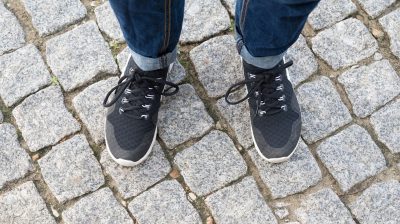8 ways to manage Social Anxiety Disorder
Learn more about Social Anxiety Disorder and how to manage it.

It is normal to feel anxious in social situations from time to time. However, people with social anxiety disorder experience intense fear and anxiety during social situations. This intense fear or anxiety interferes with aspects of their daily life, like work, school and maintaining relationships.
In this article, you will find information for managing social anxiety symptoms. The focus is on strategies that support your long-term well-being while helping you treat yourself with understanding and self-compassion.
Helpful strategies covered in this article include:
Trying talk therapy
Challenging biased thought patterns
Practising emotion regulation
Trusting in your own abilities
Focusing on the positive aspects of social interactions
Shifting your attention away from yourself
Replacing rumination with problem-solving
Gradually letting go of safety behaviours
Helpful strategies for managing social anxiety
When social situations feel intensely stressful, it’s natural to look for ways to make yourself feel better. Some people may find themselves avoiding certain situations altogether or relying on substances like alcohol to cope. While doing this can offer short-term relief, not dealing with social anxiety can make it worse over time. When you avoid socialising or use alcohol to help you cope, this can strengthen the false belief that you are not capable of socialising or building relationships without it.
Below are some evidence-based, long-term strategies you might find helpful for managing your social anxiety in a less harmful way.
Try talk therapy
There are many different approaches to therapy. Most of these approaches aim to deepen your self-understanding and support meaningful change over time.
Talk therapy or psychotherapy can be a helpful way to explore difficult emotions and better understand the situations that tend to trigger them. With the support of a fully qualified and accredited counsellor or psychotherapist, you can reflect on where these emotions may come from, including past experiences, and how they continue to affect your thoughts, behaviours, and relationships.
When it comes to social anxiety, therapy can help you to:
- Develop personalised and sustainable strategies for managing anxiety in social situations
- Challenge self-critical or distorted beliefs about how you come across to others
- Gradually reduce your reliance on avoidance or other short-term coping strategies that may be reinforcing your anxiety
Over time, these changes can help you feel more confident in your ability to manage difficult emotions during social interactions and respond to them in ways that support your wellbeing.
Cognitive Behavioural Therapy (CBT)
Cognitive Behavioural Therapy (CBT) is one of the most well-researched and effective psychological treatments for social anxiety. There are specific CBT approaches designed for people with social anxiety, which take into account the particular patterns of thinking and behaviour associated with it.
With the support of a therapist, CBT can help you learn to manage difficult emotions by identifying and changing unhelpful patterns of thinking. This includes how you tend to interpret social situations, especially those interactions where a person’s behaviour or intention might seem ambiguous or unclear. Ambiguous situations are those where social cues, like facial expressions, tone of voice, or body language, are open to interpretation, and people with social anxiety often assume the worst in these moments. CBT can support you in learning to notice, question, and reframe these assumptions.
CBT isn’t the only helpful approach, and it may not be the right fit for everyone. What matters most is finding a therapy and a therapist that feels meaningful and accessible to you. This may include considering your cultural background, personal experiences, and how you naturally process information.
If you are unsure where to begin, you can read more about the different types of therapy and how to find a therapist who works in an inclusive and culturally sensitive way.
Challenge biased thought patterns
CBT for social anxiety helps you to examine and challenge negative or biased patterns of thinking about social situations. However, changing biased thought patterns is something you can also try on your own.
Social anxiety can lead you to view certain situations, like giving a presentation, speaking in a group, or answering the phone, as more threatening than they are. It is also common to overestimate the chances of being judged, embarrassed, or rejected in these moments.
One helpful step is to gently question the beliefs or assumptions that come up when you are feeling anxious. You might ask yourself:
- Is there evidence to support this belief about myself? For example, you may believe you lack social skills or always come across badly in conversations. Ask yourself whether that belief is based on facts or on a few difficult experiences that have shaped your thinking over time
- Am I assuming something about what others expect from me? You might find yourself imagining that people have very high standards or are constantly evaluating your behaviour. These assumptions can lead to a feeling of falling short, even when others might not be judging you at all
Practise emotion regulation strategies
For many people with social anxiety, one of the most distressing parts of social situations is the sense of losing control, particularly over visible signs of anxiety, such as blushing, shaking, or stumbling over words. This can lead to feelings of humiliation, vulnerability, and a strong urge to escape the situation.
Learning to manage difficult emotions as they arise can help reduce this sense of threat. Over time, practising helpful emotion regulation strategies can give you a greater sense of control in situations that might otherwise feel overwhelming.
Emotion regulation is about noticing, managing, and responding to your emotions in ways that are appropriate to the situation and supportive of your wellbeing. For example, challenging unhelpful or overly negative thoughts or using problem-solving can help reduce anxiety. The opposite tends to be true for avoiding social situations or criticising yourself harshly.
There is also some evidence that being able to identify and make sense of both your own emotions and those of others, sometimes called emotional awareness, is linked to lower levels of social anxiety.
To explore this further, you can read our article on emotion regulation strategies for managing anxiety, which explains the difference between helpful and unhelpful approaches.
Build trust in your abilities
Learning new ways to manage social anxiety, such as practising emotion regulation or changing how you think about situations, can take time. It’s normal to feel uncertain or doubt yourself along the way. Many people with social anxiety struggle with negative beliefs about themselves and their ability to handle difficult situations, which can make it harder to trust in their own coping skills.
You might find yourself seeking reassurance from others when you feel overwhelmed. While it’s understandable to turn to people you trust, relying too heavily on others to regulate your emotions can, over time, undermine your confidence in your ability to manage them. Research suggests that the more you practise helpful strategies, like reframing your thoughts or problem-solving, the more confident you’re likely to feel. Social anxiety can also lead you to underestimate your own social skills. You may assume that others are more confident, articulate, or socially capable than you are, but this belief isn’t usually accurate. In fact, studies show that people with social anxiety generally have similar social skills to those without social anxiety. The difference is that anxiety can interfere with your ability to use these skills when you most need them.
With time and repeated practice, it is possible to build a stronger sense of trust in your own emotional and social capacities, even if you do not always feel you can use them in moments of anxiety.
Focus on the positive aspects of social interactions
Social anxiety is often driven by a strong fear that others are judging you harshly or noticing your mistakes. It is common for socially anxious people to focus on moments they believe went wrong or to confirm negative beliefs about their social performance.
Because of this tendency to focus on the negative, it can be helpful to intentionally shift your attention after a social interaction. Rather than replaying what you think went poorly, try to reflect on what went well, even if it is only a small detail. Did you stay present in the conversation? Did you express yourself, even while feeling nervous? Noticing these moments can help you develop a more balanced, accurate view of yourself.
Challenging your view of yourself can be hard. Some people with social anxiety also experience what psychologists call a fear of positive evaluation. This means that even when things go well, you may feel anxious. This might be because you’re afraid that others will expect more from you in the future, or that you’ll be unable to live up to a new, higher social standard. This fear can make it difficult to accept positive feedback or enjoy your successes.
If you notice these thoughts, try gently questioning them. Ask yourself: Is there any evidence that others expect perfection from me? Do I hold myself to a higher standard than I do others?
Over time, making space for a more balanced view of your social interactions and yourself can help ease anxiety and build your confidence.
Shift your attention away from yourself
Studies show that people with social anxiety often focus intensely on themselves during social interactions, monitoring their own behaviour and appearance in a highly self-critical way. People often do this because of a fear of negative judgment and wanting to meet what they perceive as others’ high social expectations.
While this response is understandable, focusing too much on yourself can mean missing important cues from others, such as signs that the interaction is going well or that the other person is engaged and responding positively.
When you find yourself caught in this pattern, try gently redirecting your attention. Focus on the environment around you or listen carefully to what the other person is saying. Even brief moments of fully immersing yourself in the conversation can help reduce self-consciousness and ease anxiety.
Practising grounding exercises, mindfulness techniques, or deep breathing can support this shift in attention and help you stay connected to the present moment.
Replace rumination with problem-solving
Many people with social anxiety find themselves ruminating after social interactions. Rumination is an unhelpful way of managing difficult emotions that involves repeatedly focusing on a problem, including its causes and effects, without taking any action to resolve it or reframe the way you view it. In the context of social anxiety, this might mean replaying everything you think you did wrong or could have done better, which often increases social anxiety symptoms over time.
Problem-solving may offer a more helpful alternative. Like rumination, it involves thinking carefully about a problem, but it also includes choosing and taking specific steps to address it based on your particular circumstances and the resources or support you have available to you at the time.
After a stressful social interaction, you might try to identify exactly what triggered your anxiety and consider practical ways of supporting yourself to feel more comfortable next time. Ideally, these strategies do not rely on avoidance. For example, if you felt anxious because you struggled to join a group conversation, you might plan to prepare a few topics or questions in advance to help you engage more easily next time.
Gradually let go of safety behaviours
Safety behaviours are actions or behaviours that socially anxious people use to reduce distress or hide their anxiety in social situations. Examples include:
- Smiling at inappropriate times
- Drinking alcohol before social encounters
- Avoiding eye contact
If you experience social anxiety symptoms, you might find that you have been relying on some of these behaviours without knowing. It can be helpful to reflect on which situations you might be avoiding or what safety behaviours you tend to use when feeling anxious. Gaining an awareness of these patterns is the first step toward change.
Once you have identified some of these behaviours, you can begin to gradually reduce your reliance on them during social interactions. Over time, this process can build your confidence in managing social encounters without these unhelpful coping mechanisms. Although safety behaviours may feel helpful in the short term, they often increase social anxiety in the long run by reinforcing the belief that everyday social situations are more threatening than they really are.
Feeling overwhelmed and want to talk to someone?
- Get anonymous support 24/7 with our text message support service
- Connect with a trained volunteer who will listen to you, and help you to move forward feeling better
- Whatsapp us now or free-text SPUNOUT to 50808 to begin.
- Find out more about our text message support service
If you are a customer of the 48 or An Post network or cannot get through using the ‘50808’ short code please text HELLO to 086 1800 280 (standard message rates may apply). Some smaller networks do not support short codes like ‘50808’.






